How Figure a Beef Animals Esitmated Meat
Published: 2021-03-23

Americans have the highest meat consumption in the world. The Meat Blitz-Calculator shows you how it all adds up, based on your personal diet. Like: How many animals have to be raised to satisfy your appetite? How many resources are needed to produce this livestock? And would the environment and climate profit if meat was replaced by vegetarian alternatives?
Meat Calculator
All data used is based on Meat Consumption in the US.
According to the United States Department of Agriculture (USDA), every American consumes more than 260 lbs carcass weight of meat (red meat and poultry) per year. [source: ERS Food Availability (Per Capita) Data System (FADS) – red meat and poultry]. With this consumption level per capita, the Americans are the largest group of meat-consumers in the world. [source: OECD Data Meat Consumption]
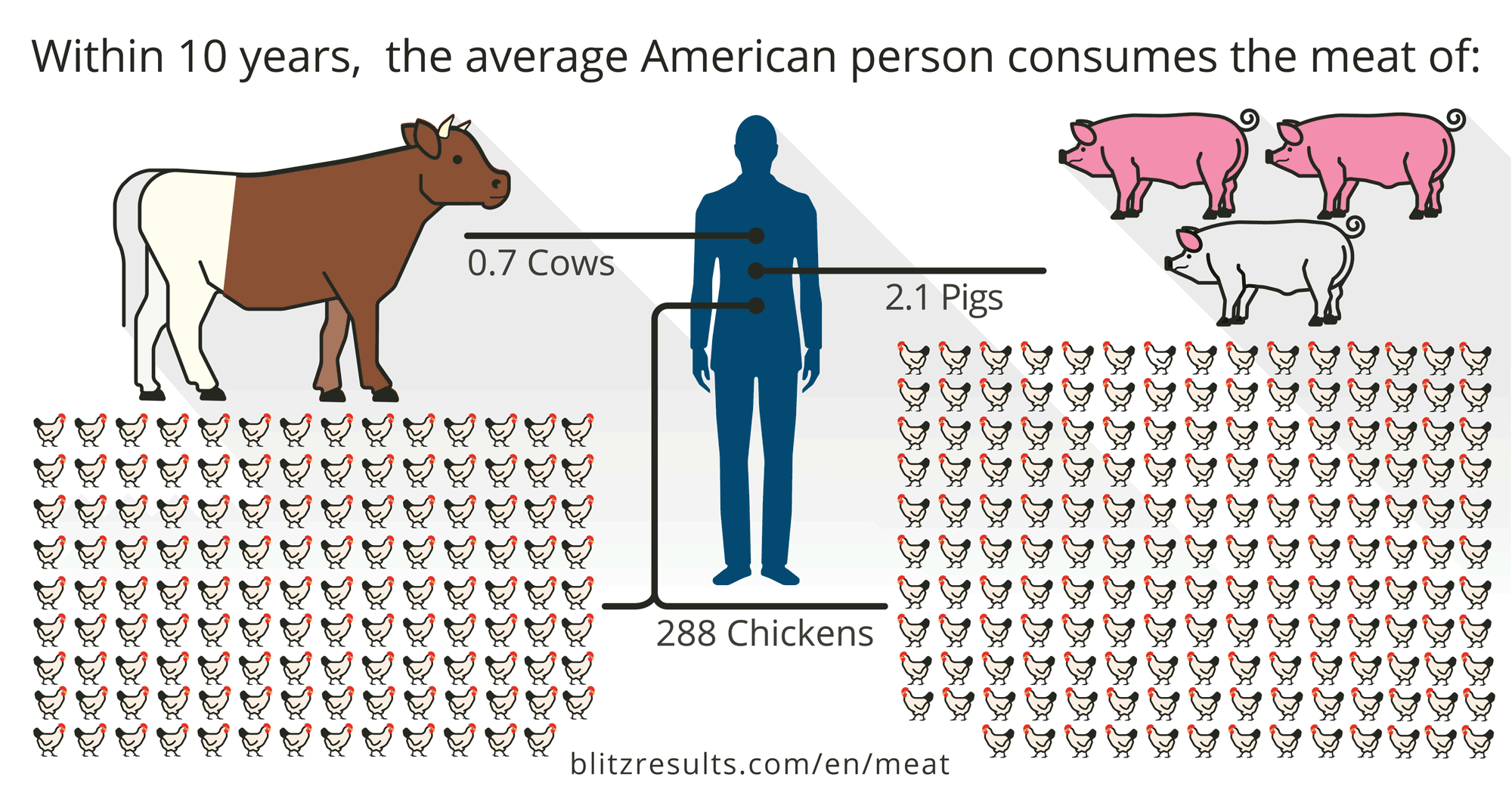
Free Infographic (CC). See details.
The problem: the consumption of such quantities of meat has a negative impact on the environment and climate. The high degree of cultivation of farmland and pastureland plays an important role in this context. While pure vegetable foods can be processed and consumed directly, meat products have several detours. Before an animal product is put on the plate for consumption, the animal must be fed. According to the USDA, roughly 40 percent of the domestic used grains goes into feeds and residual usage. The efficiency how animals convert grain into meat varies significantly. In the US, cattle are mostly held in feedlots. Here it takes roughly 7 pounds of grain to produce 1 pound of beef. For pork, the ratio is 4:1, for poultry it is roughly 2:1. [source: USDA Feed Grains Database]
Use of antibiotics in animal husbandry
Animals in factory farming are prone to illness. Antibiotics are used as a countermeasure. A total of 30 million pounds of antimicrobials were sold for use on food-producing animals in the United States, which represents 80% of all antibiotics used in the United States. [source: FDA].
This has huge negative side-effects. Last year approx. 23,000 Americans died and nearly 2 million suffered illnesses from antibiotic-resistant bacterial infections and these numbers are increasing. It is difficult to say how many human infections are related to resistance that emerged from animals. But one thing is clear: the more antibiotics we use, the less effective they become. No matter whether applied to humans or for animals, the overuse contributes to the development of dangerous superbugs.
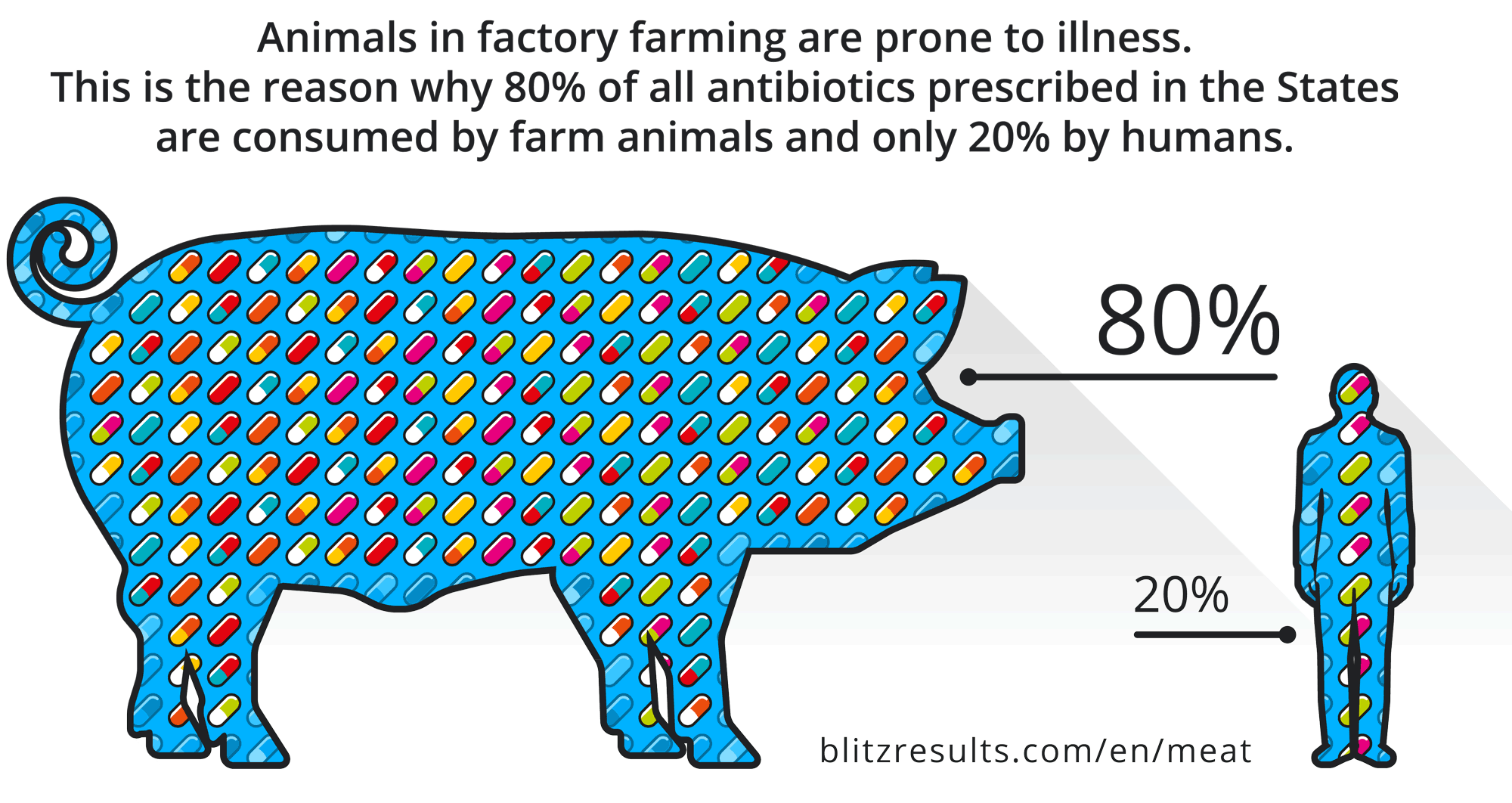
Free Infographic (CC). See details.
Meat Consumption by Country
| Country | Kg/Person |
|---|---|
| Australia | 111.5 |
| Brazil | 85.3 |
| Canada | 94.3 |
| China | 58.2 |
| Cuba | 49.4 |
| India | 4.4 |
| Indonesia | 11.6 |
| Ireland | 87.9 |
| Israel | 96 |
| Malaysia | 52.3 |
| Mexico | 63.8 |
| Namibia | 28.3 |
| Nigeria | 8.8 |
| North Korea | 13.4 |
| Philippines | 33.6 |
| Russia | 69.2 |
| Saudi Arabia | 54.4 |
| South Africa | 58.6 |
| Spain | 97 |
| United Arab Emirates | 73.8 |
| United Kingdom | 84.2 |
Source: Food and Agriculture Organization of the United Nations (FAO), FAOSTAT online statistical service.
Meat consumption and CO2 emissions
High meat consumption also has a considerable impact on climate change. On the one hand, grasslands and forests are transformed into fields or pastures. The clearing of trees and humus degradation causes large amounts of CO2 to escape into the atmosphere.
The animals themselves, above all cattle, also produce climate-damaging gases such as excess methane. For example, a single cow releases more than 50 US gallons of methane gas per day into the atmosphere. It damages the climate in the same way as a small car that covers a distance of 11,000 miles. [source: Carbon and Balance Management]
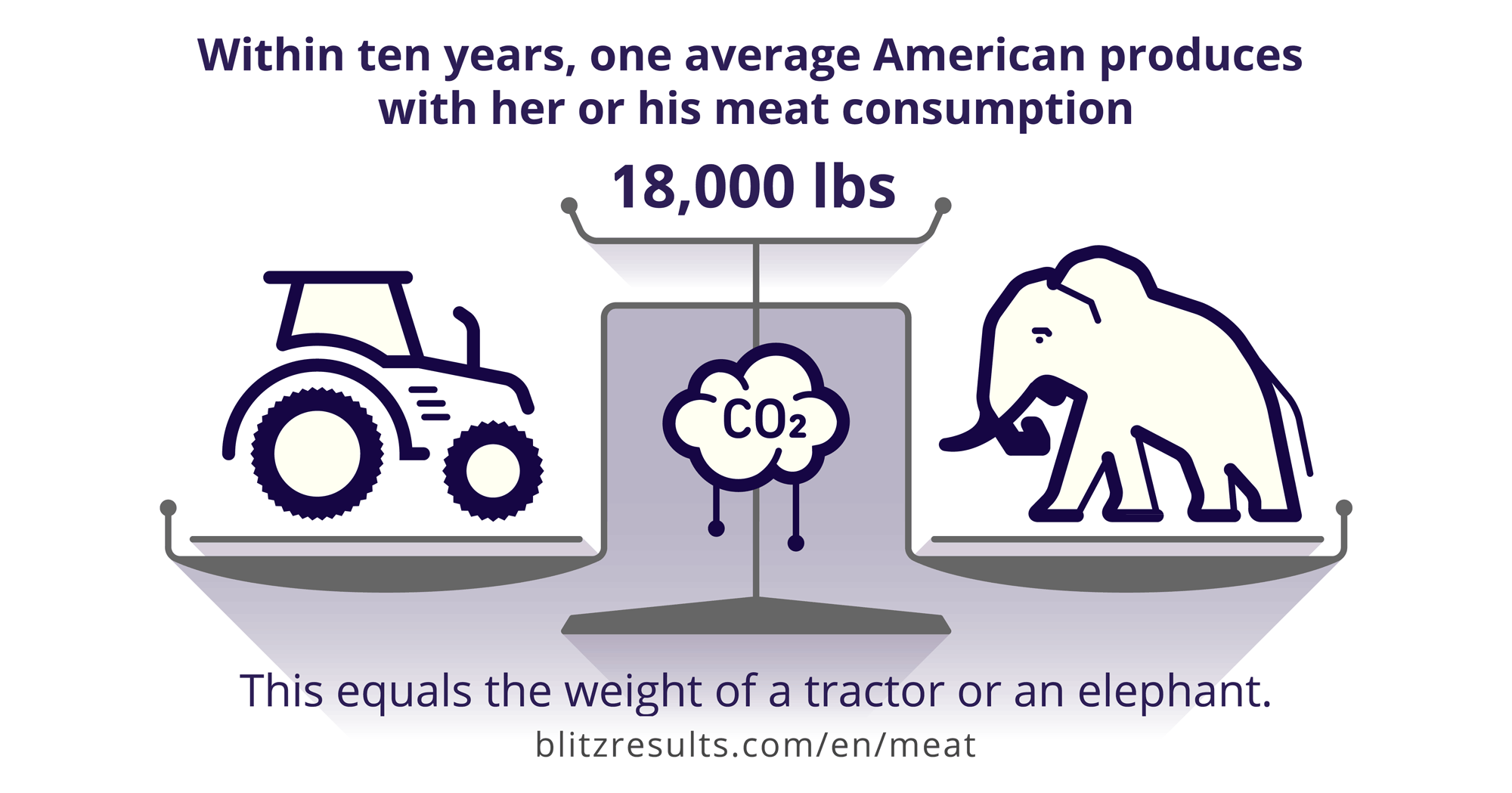
Free Infographic (CC). See details.
Raising live stock needs a lot of land
In the United States, more than 25% of the total land base is used for pasture and range. In addition, roughly 20% is cropland. If you consider that nearly 40% of the crops are used to feed the livestock, this means that more than one-third of the total land base is solely used to produce meat.
Restrict meat consumption?
Despite these effects on the environment and repeated scandals such as the one related to JBS and Brazilian meat, many Americans are still reluctant to give up meat.
Around 85 percent of the population does not want to miss meat products. On the other hand, there are growing signs of a mindset change observable in the US. In 2017, 6% of US consumers now claim to be vegan, up from just 1% in 2014. The same study also states that consumers are showing a growing awareness of the impact of meat consumption and hence are looking for more ethically produced and environmentally sustainable foods. This also applies to by-products like leather that is used for shoes and clothes (e.g. pants). [source: Reportbuyer].
Besides humans, more than 150 million domestic cats and dogs make up the second largest group of meat eaters in the US. Hardly any dog food or cat food can do without meat. [source: AVMA]
Vegetarians and Vegans
Vegetarians are still a minority of the total population. But the number of people who refuse to eat meat is constantly increasing. According to Harris Poll from 2016, it can be estimated that approximately eight million adults in the US are vegetarians, this represents ca. 3.3% of the population. About half of the vegetarians were also vegan. Looking at the demographics in the Harris Poll shows that adults between 18 and 34 are nearly twice as often vegetarians than people over 50 are. [source: VRG]
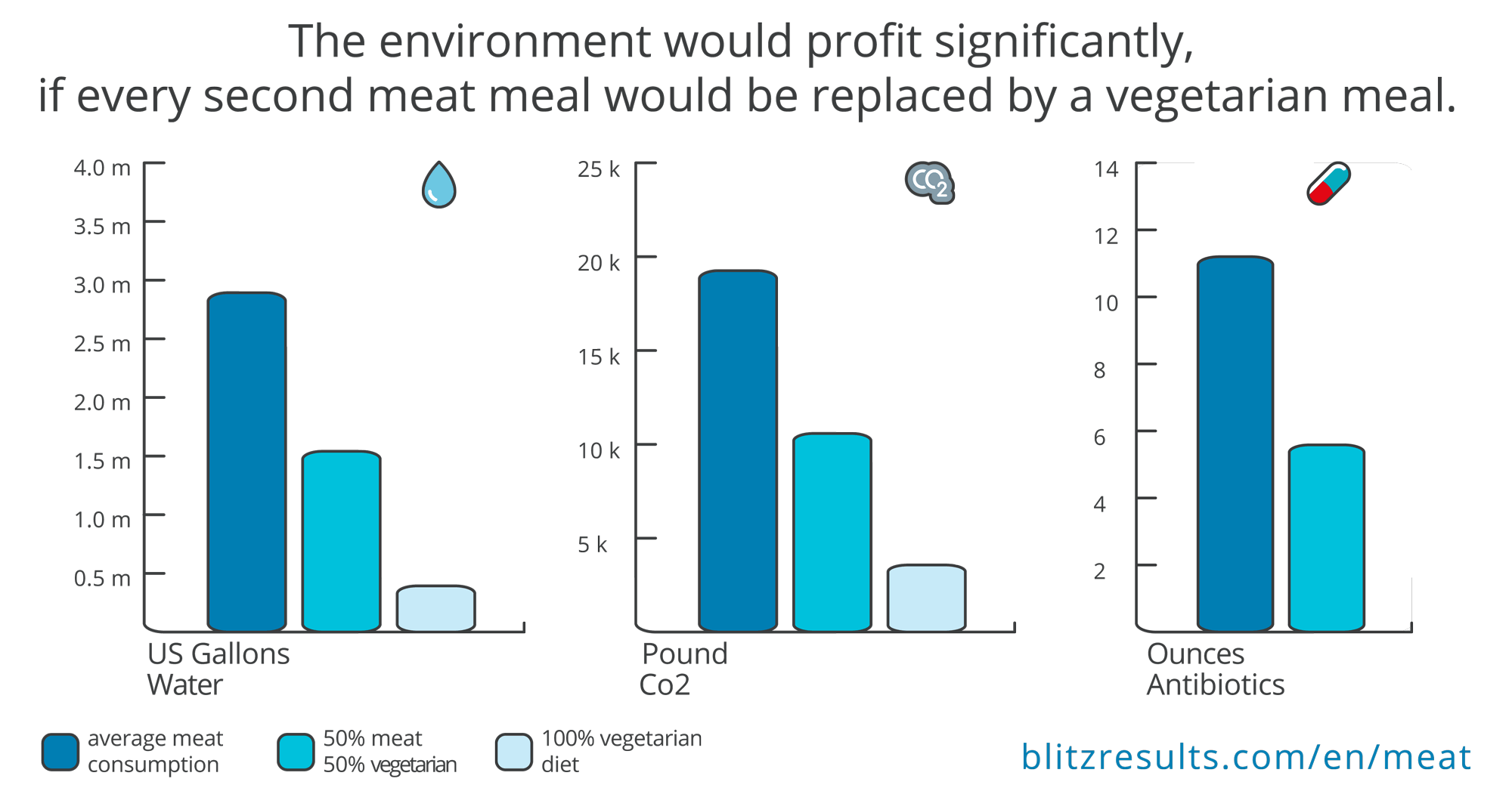
Free Infographic (CC). See details.
Regardless of the still small number of vegetarians and vegans, more and more people are looking for tasty meat alternatives. This means that the demand for vegetarian products is rising continuously. Data from Spins (which does not include some retailers such as Whole Foods, Costco and Trader Joe's) shows that plant-based versions of meat, tofu, milk, yogurt, cheese, and cream have grown more than 8.7% during the past two years (general food and beverage sector growth was 3.7%). [source: Soyfoods]
Tofu as an alternative to meat?
Many critics complain about the consistency and rather neutral taste of unprocessed tofu. What annoys some people, makes others happy: Due to its almost unspectacular taste, it is suitable for a wide variety of dishes and can be seasoned or marinated as desired. According to personal preference, it can be placed in marinades with garlic, soy sauce, curry, coconut milk or lime juice. It can be grilled, baked, roasted or diced and added to soups.

On the shelves of supermarkets, you can often find smoked tofu, which has a strong and tart flavor. Smoked tofu is mostly used as a sandwich topping, in salads, fried with rice or in vegetable dishes. Sausage and ham lovers often concede a strong aroma and taste to it, but do not regard it as a really tasty substitute. Nevertheless, it has enjoyed increasing popularity for years as a vegetarian spread, tofu sausage or soya escalope.
In recent years, roasters have also become more and more popular. They are usually made up of tofu/soy products, a wide variety of vegetables or cereals. Particularly popular ingredients are oat flakes, carrots, zucchini, rice, couscous, lentils, millet or quinoa.
Meat and tofu in direct comparison
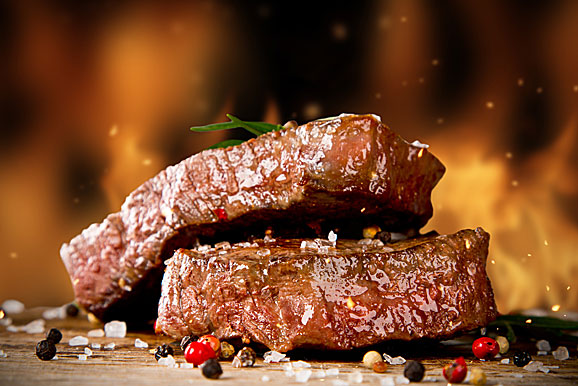
Both foods contain valuable proteins. Tofu contains 7 to 15% of easily digestible protein components, including all eight essential amino acids. The protein content of meat is 15 to 40%. [source: Wikipedia]
- Tofu contains less fat and therefore, your caloric consumption is fewer than when you eat meat. While one serving (4 oz.) of tofu contains about 80 – 120 kcal, the same amount of meat yields up to 350 kcal. Sausage contains even more calories and therefore tends to have a rather negative effect on BMI.
- Meat has a significantly higher concentration of B vitamins. Tofu contains large amounts of minerals, above all magnesium and calcium.
- Tofu is almost cholesterol-free. On the other hand, depending on the type of meat, 1 serving meat (4 oz.) contains 70 to 400 mg of cholesterol.
- The production of meat is much more resource-intensive and has a much greater impact on the environment and climate than the cultivation of soybeans.
- Meat has its own characteristic taste. Tofu, on the other hand, tastes rather bland.
The future of nutrition? And how does soy fit in?
Meat is sometimes regarded as "the new cigarette". Experts claim that meat consumption in the United States will decrease in the coming years and decades. [source: NRDC]. However, global meat consumption will increase sharply in the future, as the world's growing middle class wants to consume more animal proteins. Soy as a replacement will play an increasingly important role in nutrition as a healthy and environmentally friendly alternative to meat.

Is a vegetarian diet also suited for kids?
Both, the American Academy of Pediatrics and the Academy of Nutrition and Dietetics, state clearly that vegetarian and vegan diets are healthy and suitable for children as well [more information about vegetarian nutrition for kids]. But just like for meat-eating children, you need to make sure that your child gets all the essential nutrients to help them grow and develop normally.
About the Meat Calculator
The meat calculator calculates the resources required for the animal husbandry of one's own meat requirements. In particular, feed, antibiotics, land use and water pollution are examined. Consumption of meat is estimated for a given amount of years. Standard values such as the average meat consumption are already pre-filled, but can easily be adapted to your own eating habits. In this way, everyone receives their own personal result.
In a second step, it is possible to simulate how many resources can be saved by replacing part of the meat meals with a vegetarian alternative. In the case of the meat calculator, tofu was chosen as a vegetarian alternative, since it is probably the best-known and most widespread meat substitute.
However, tofu was only used as an example for vegetarian nutrition. It serves as a symbolization and as a vehicle for a thought experiment. Instead of tofu, however, pulses or vegetables could also have been used for a calculation. Nevertheless, tofu is of course only one of many, many possible substitutes for vegetarian nutrition. And there are also many vegetarians and vegans who do not eat tofu at all.
Sources, formulas, and references to the meat calculator
At first glance, the meat consumption stored in the calculator seems to be very high and most people estimate their own meat consumption to be much lower. How come? Meat is consumed more often than one might think, unconsciously or due to lack knowledge about the actual meat content of the products. We are often unaware of how much meat the Bolognese sauce, pizza or meat salad actually contains. In addition, there is a phenomenon that nutritional research calls "hidden meat". For example, gelatin in jelly beans or components of pork, beef, and poultry in potato chips.
The pre-filled values for meat consumption during the week are based on the results of the ERS Food Availability (Per Capita) Data System (FADS).
Note: It needs to be distinguished between the weight of the meat ending up on your plate (so-called retail weight) and the carcass weight of the animals. The carcass weight means the warm weight of animals directly after slaughter. This means that limbs, innards and the skin of the cow have already been removed. Bones, cartilage, tendons and other inedible parts of the farm animals are still included. On average approx. 60% of the carcass weight is edible. Values entered by you above in the calculator are retail weights. However, the carcass weight is used to calculate the results (i.e. number of slaughtered animals, CO2, water).
| Average Meat Consumption per year | Divided by 52 weeks | |
|---|---|---|
| Pork | 46.3 lbs | 14.2 oz |
| Beef & Veal | 51.6 lbs | 15.9 oz |
| Poultry | 75.1 lbs | 23.1 oz |
Water consumption & CO2 emissions
The following values are used to calculate water consumption and CO2 emissions. The values given refer to the production of 1 lbs of meat or tofu:
| Tofu | Beef & Veal | Poultry | Pork | |
|---|---|---|---|---|
| Water usage in US gallons per lbs meat | 111 | 1845 | 515 | 719 |
| CO2 production in lbs per lbs meat | 1.1 | 13.3 | 3.5 | 3.3 |
[source: Water Footprint Network and Öko-Institut]
Use of antibiotics
According to the PEW charitable trusts, today there is little information about the use of antibiotics and the development of resistance in intensive animal husbandry. Only in 2016, the U.S. Food and Drug Administration (FDA) finalized a rule requiring that animal drug companies estimate the amount of antibiotics sold for use in pigs, cows, chickens, and turkeys each year. The only national estimates of total antibiotic use in U.S. food animal production come from sales data. In 2015 approximately 21.4 million pounds, of antibiotics were sold for use in animal agriculture. These numbers are taken into account when calculating the effects of your meat consumption. [source: FDA]
Calculation procedure
Reference values such as water consumption and CO2 emissions always refer to 1 lbs of meat and are extrapolated from weekly values to ten years.
Annual consumption of water, CO2 and antibiotics
Calculation of the annual water consumption and CO2 emissions by simple multiplication with the annual meat consumption:
\text{Water consumption}= \\ \text{(Meat consumption per year in lbs)}\times\text{(Water usage to produce 1 lbs of carcass weight of meat)}
\text{CO2 consumption}= \\ \text{(Annual Meat Consumption in lbs)}\times\text{(CO2 usage to produce 1 lbs of carcass weight of meat)}
When meat is substituted by tofu, resource consumption is reduced. This is illustrated in the following on the basis of water consumption. First of all, the water quantities are calculated which are avoided by renunciation of meat. The already determined water consumption at 100% meat consumption is multiplied by the proportion to be replaced by tofu:
\text{Water saved in lbs}= \\ \text{(Water used if meat is consumed)}\times\text{(Share of Tofu in Percent)}
The amount of water required for the production of the tofu itself is subtracted from this amount:
\text{Water consumption in Tofu production}= \\ \text{(Annual Meat Consumption in lbs)}\times\text{(Share of Tofu in Percent)}\times\text{111 US gallons}
First, the actual meat consumption per year is multiplied in pounds by the tofu content in order to determine the amount of tofu consumed. This is then multiplied by the amount of water required (111 US gallons) to produce 1 pound of tofu and subtracted. The same procedure is used to determine the CO2 emissions saved.
To calculate the number of antibiotic treatments, the number of animals slaughtered is first determined and multiplied by the average antibiotic treatments.
\text{Slaughtered animals per year}= \\ \frac{\text{(Annual Meat consumption in lbs)}}{\text{(Retail weight of meat per animal in lbs)}}
The following average values for the retail weight are assumed:
- pork: 213¹ lbs edible meat
- beef & veal: 801² lbs edible meat
- poultry: 2.6 lbs edible meat
Source: Calculated by ERS/USDA based on data from various sources – red meat and poultry
At a Glance
- The per capita meat consumption of the US Americans is the highest in the world.
- Production of meat and factory farming cause many problems: feed requirements, use of antibiotics, water consumption, CO2 emissions.
- Soy is an "efficient" foodstuff and can replace meat in terms of nutritional physiology. It also has ecological advantages. But, for many people, in terms of taste, tofu is not an equivalent meat substitute for many people.
- The importance of vegetarian and vegan alternatives is constantly increasing. Women are often a little more keen to experiment with vegetarian and vegan food. Nowadays, many discounters and supermarkets already offer a small assortment.
- Discussions between vegetarians and dyed-in-the-wool meat eaters are unfortunately often still very emotional. Respecting the other person's diet and way of life is always a good idea.
stoughtonintrotill.blogspot.com
Source: https://www.blitzresults.com/en/meat/
0 Response to "How Figure a Beef Animals Esitmated Meat"
Post a Comment